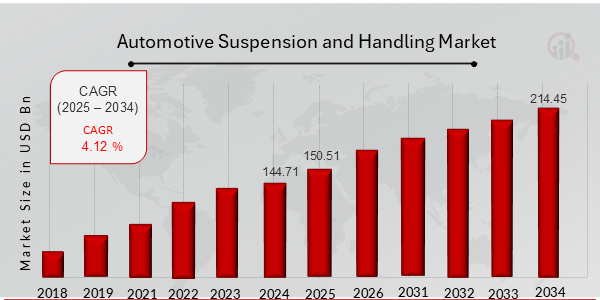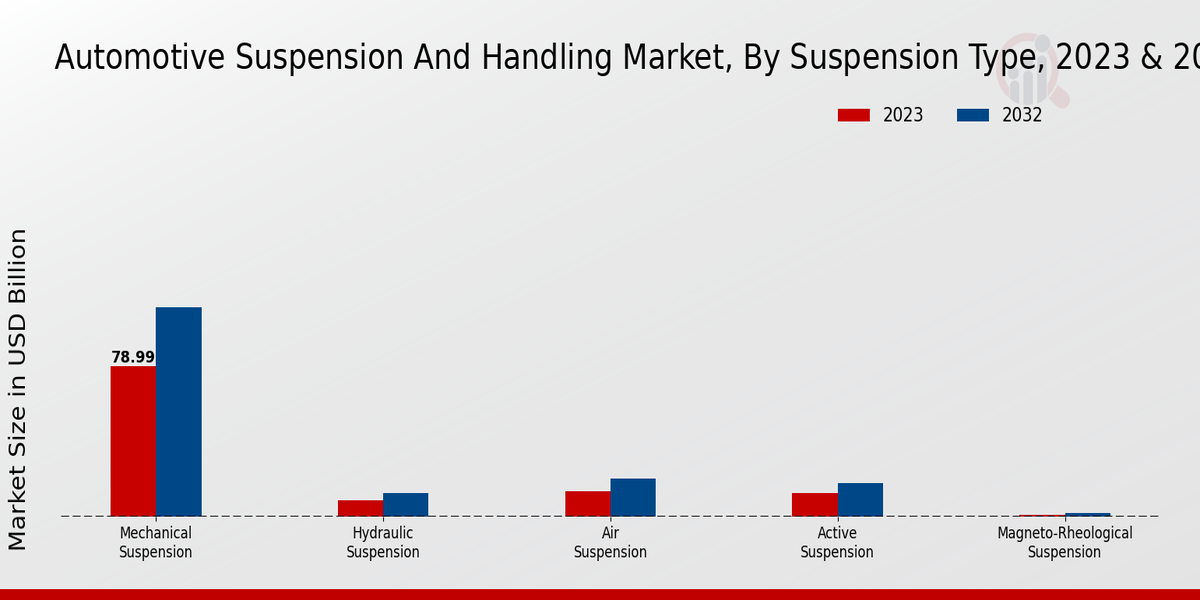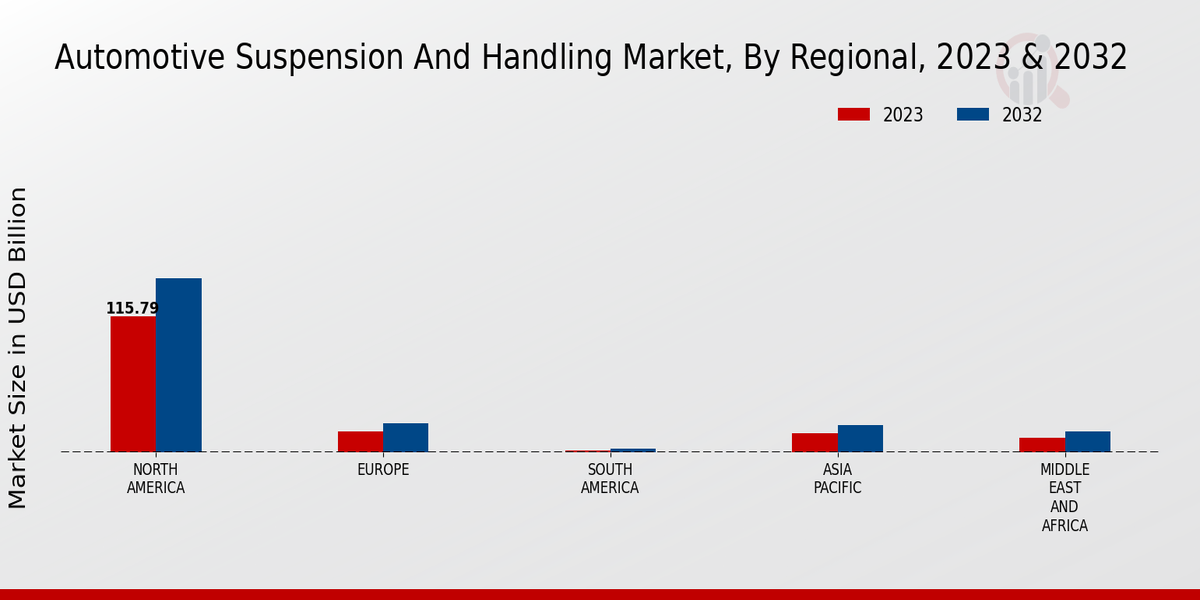Automotive Suspension and Handling Market Overview:
As per MRFR analysis, the Automotive Suspension and Handling Market Size was estimated at 144.71 (USD Billion) in 2024. The Automotive Suspension and Handling Market Industry is expected to grow from 150.51 (USD Billion) in 2025 to 214.45 (USD Billion) till 2034, at a CAGR (growth rate) is expected to be around 4.12% during the forecast period (2025 - 2034).
Key Automotive Suspension and Handling Market Trends Highlighted
Key market drivers include rising demand for enhanced vehicle stability and handling, increasing adoption of advanced suspension systems like air suspensions and magnetic ride control, and growing emphasis on passenger comfort and safety.
Opportunities lie in the integration of advanced technologies, such as sensors and actuators, to improve suspension performance and ride quality.
Recent trends in the automotive suspension and handling market include the adoption of lightweight materials to reduce vehicle weight and improve fuel efficiency, the incorporation of semi-active and active suspension systems for adaptive damping and improved handling, and the development of intelligent suspension systems that can adjust to different road conditions and driving styles.
The market is expected to witness advancements in areas such as electronic stability control, traction control systems, and active roll stabilization systems.
These technologies will play a significant role in enhancing vehicle safety and handling capabilities, particularly in challenging driving conditions.

Source: Primary Research, Secondary Research, MRFR Database and Analyst Review
Automotive Suspension and Handling Market Drivers
Increasing Demand for Advanced Suspension Systems
One of the most significant market drivers in the global automotive suspension and handling market is the increasing demand for advanced suspension systems. As vehicles become more advanced, and consumers demand a more comfortable and fun driving experience, then the need for advanced suspension systems, which can provide better handling, stability, and ride quality, is also increased.
Moreover, advanced suspension systems also offer improved fuel efficiency and reduced emissions, which is becoming progressively more important in the face of raised environmental awareness.
There are several types of advanced suspension systems that are currently available. Each type of suspension system has its own advantages and disadvantage. Some of the most popular types of suspension systems are presented below: air suspension, magnetic ride control, and hydraulic suspension.
Air suspension uses air bags to support the weight of the vehicle. Air bags can be easily expanded and contracted to provide a very comfortable ride, which makes them popular with mass-produced luxury cars.
Air suspension systems are also relatively easy to maintain and repair. Magnetic ride control uses electromagnetic dampers, which can be easily adjusted to provide dynamic road handling. The system is very responsive, and the dampers can be adjusted in real-time to keep the ride under control.
Unfortunately, magnetic ride control is also an expensive type of suspension, and most drivers have to do without it. Hydraulic suspension uses hydraulic fluid to provide maximum comfort.
The ride is very smooth and comfortable, and the hydraulic fluid can easily absorb all the shocks from the road. Moreover, hydraulic suspension systems are also relatively easy to maintain and repair.
The demand for advanced suspension systems is only likely to increase in the coming years as the world’s affluence continues to grow, and people are becoming more concerned with the products and services they consume.
The demand for better comfort and quality of the ride is already driving growth in the global automotive suspension and handling market.
Growing Popularity of SUVs and Crossovers
The growing popularity of SUVs and crossovers is another important market driver in the global automotive suspension and handling market. SUVs and crossovers are typically heavier and taller than sedans, which requires more sophisticated suspension systems to provide adequate handling and stability.
Additionally, SUVs and crossovers are often used for off-road driving, which requires suspension systems that can handle rough terrain.
The growing popularity of SUVs and crossovers is expected to continue in the coming years, as consumers continue to seek out vehicles that offer a combination of comfort, utility, and off-road capability. This is expected to drive growth in the global automotive suspension and handling market.
Increasing Adoption of Electric Vehicles
The increasing adoption of electric vehicles is another important market driver in the global automotive suspension and handling market. Electric vehicles are typically heavier than gasoline-powered vehicles, which require more sophisticated suspension systems to provide adequate handling and stability.
Additionally, electric vehicles often have different weight distribution characteristics than gasoline-powered vehicles, which can also affect the suspension system design.
The increasing adoption of electric vehicles is expected to continue in the coming years, as governments around the world implement policies to reduce emissions and consumers become more aware of the environmental benefits of electric vehicles. This is expected to drive growth in the global automotive suspension and handling market.
Automotive Suspension and Handling Market Segment Insights:
Automotive Suspension and Handling Market Suspension Type Insights
The global automotive suspension and handling market is segmented into various types of suspension systems, including Mechanical Suspension, Hydraulic Suspension, Air Suspension, Active Suspension, and Magneto-Rheological Suspension.
Each type offers unique advantages and is suitable for different vehicle applications and performance requirements. Mechanical Suspension, the most widely used type, utilizes springs and shock absorbers to control vehicle movement. Its simplicity, durability, and affordability make it a popular choice for budget-friendly vehicles and commercial applications.
However, it offers limited adjustability and ride comfort compared to other types. Hydraulic Suspension employs hydraulic fluid to dampen vibrations and control vehicle movement. It provides a smoother and more comfortable ride than Mechanical Suspension, especially for heavy-duty vehicles and off-road applications.
However, it requires regular maintenance and can be more expensive to repair. Air Suspension utilizes compressed air to support the vehicle's weight and absorb road irregularities. It offers excellent ride comfort, adjustable ride height, and load-leveling capabilities.
However, it can be more complex and costly than other suspension types and requires regular maintenance to prevent air leaks.
Active Suspension employs sensors and actuators to actively control the suspension system, adjusting damping and stiffness in real time. It provides exceptional ride comfort, handling, and stability, especially for high-performance vehicles. However, it is the most expensive and complex suspension type, requiring advanced control algorithms and sophisticated components.
The magneto-rheological suspension uses magnetically controlled fluids to adjust damping force, offering a balance between ride comfort and handling.
It is relatively new in the automotive industry but has gained traction in performance and luxury vehicles due to its quick response and adaptability to varying road conditions. The market growth for each suspension type varies depending on factors such as vehicle type, performance requirements, and consumer preferences.
Mechanical Suspension is expected to remain dominant in the budget segment, while Air Suspension and Active Suspension are gaining popularity in the premium and performance segments.
Hydraulic Suspension is anticipated to maintain a steady presence in heavy-duty vehicles and off-road applications, and Magneto-Rheological Suspension is expected to experience niche growth in high-end vehicles.

Source: Primary Research, Secondary Research, MRFR Database and Analyst Review
Automotive Suspension and Handling Market Vehicle Type Insights
The Vehicle Type segment of the global automotive suspension and handling market is segmented into Passenger Cars, Commercial Vehicles, Off-Road Vehicles, Two-wheelers, and Electric Vehicles. Among these segments, Passenger Cars held the largest market share in 2023, accounting for over 60% of the global automotive suspension and handling market revenue.
The growth of this segment is attributed to the increasing production and sales of passenger cars globally. The Commercial Vehicles segment is expected to witness significant growth during the forecast period, owing to the rising demand for commercial vehicles for transportation of goods and services.
The Off-Road Vehicles segment is also projected to grow at a steady pace, driven by the increasing popularity of off-roading and adventure activities. The Two-wheelers segment is anticipated to grow at a moderate pace, primarily due to the increasing adoption of two-wheelers in developing countries.
The Electric Vehicles segment is expected to witness robust growth in the coming years, supported by government initiatives and incentives to promote the adoption of electric vehicles.
Automotive Suspension and Handling Market Application Insights
The global automotive suspension and handling market, segmented by Application, comprises Front Suspension, Rear Suspension, and All-Wheel Suspension. Front Suspension held the largest market share in 2023, accounting for nearly 55% of the global automotive suspension and handling market revenue.
The dominance of Front Suspension can be attributed to the increasing demand for enhanced vehicle stability and handling, particularly in high-performance and luxury vehicles. Rear Suspension is projected to witness steady growth over the forecast period, owing to the rising popularity of lightweight and fuel-efficient vehicles.
All-wheel suspension is anticipated to gain traction due to its ability to provide superior traction and stability, especially in off-road and adverse weather conditions.
Automotive Suspension and Handling Market Material Insights
The Material segment of the global automotive suspension and handling market is expected to exhibit significant growth in the coming years. The increasing demand for lightweight and fuel-efficient vehicles is driving the growth of the market.
Steel is the most commonly used material in automotive suspension and handling systems due to its high strength and durability. However, aluminum is gaining popularity as it is lighter and more corrosion-resistant than steel. Composite materials are also becoming increasingly popular due to their high strength-to-weight ratio and their ability to be molded into complex shapes.
Rubber and polyurethane are also used in suspension and handling systems, primarily for their vibration-damping and noise-reduction properties.
Automotive Suspension and Handling Market Regional Insights
The regional segmentation of the global automotive suspension and handling market presents unique insights into market growth and dynamics.
North America holds a significant market share due to the presence of leading automotive manufacturers and a high demand for premium vehicles. Europe follows closely, driven by government regulations on safety and emission standards.
APAC is projected to witness substantial growth over the forecast period, attributed to the rising automobile production in China and India. South America and MEA represent emerging markets with potential for growth, as urbanization and economic development increase the demand for vehicles.
These regional insights are crucial for businesses to understand the market landscape and tailor their strategies accordingly.

Source: Primary Research, Secondary Research, MRFR Database and Analyst Review
Automotive Suspension and Handling Market Key Players and Competitive Insights:
Major players in the automotive suspension and handling market are continuously striving to gain a competitive edge over their rivals. Leading automotive suspension and handling market players are extensively investing in research and development activities to introduce innovative products and solutions.
The automotive suspension and handling market is characterized by a high level of competition due to the presence of numerous established players. These companies are constantly vying for market share and are engaged in competitive strategies such as mergers and acquisitions, new product launches, and strategic partnerships.
The automotive suspension and handling market is witnessing significant technological advancements and the emergence of new trends. This, coupled with the growing demand for vehicles with improved suspension and handling capabilities, is driving the automotive suspension and handling market development.
TRW Automotive is a leading automotive supplier that offers a wide range of suspension and handling products. The company has a strong global presence and caters to a diverse customer base. TRW Automotive is known for its innovative technologies and its commitment to quality.
The company has a strong track record of success and is consistently ranked among the top players in the automotive suspension and handling market. TRW Automotive's key strengths include its extensive product portfolio, global reach, and commitment to innovation.
Continental AG is another major player in the automotive suspension and handling market. The company is headquartered in Germany and has a global presence. Continental AG offers a wide range of automotive components and systems, including suspension and handling products.
The company is known for its high-quality products and its focus on customer satisfaction. Continental AG has a strong track record of success and is consistently ranked among the top players in the automotive suspension and handling market.
Continental AG's key strengths include its global reach, its commitment to quality, and its focus on customer satisfaction.
Key Companies in the automotive suspension and handling market Include:
- Continental AG
- Showa Corporation
- BWI Group
- KYB India
- Dana Incorporated
- KYB Corporation
- ZF Friedrichshafen AG
- Delphi Technologies
- Tenneco
- Mando Corporation
- WABCO Holdings
- Sachs Automotive
- TRW Automotive Holdings
- JTEKT Corporation
Automotive Suspension and Handling Market Developments
The rising demand for enhanced vehicle stability and handling, coupled with increasing production of passenger cars and commercial vehicles, is driving the market growth. Technological advancements, such as the integration of active and semi-active suspension systems, are further fueling market expansion.
The market is witnessing strategic partnerships and acquisitions among key players to strengthen their product portfolio and expand their geographical reach.
For instance, in 2023, Tenneco acquired Ohlins Racing AB, a leading manufacturer of high-performance suspension systems, to enhance its product offerings in the premium and motorsport segments.
Automotive Suspension and Handling Market Segmentation Insights
- Automotive Suspension and Handling Market Suspension Type Outlook
- Mechanical Suspension
- Hydraulic Suspension
- Air Suspension
- Active Suspension
- Magneto-Rheological Suspension
- Automotive Suspension and Handling Market Vehicle Type Outlook
- Passenger Cars
- Commercial Vehicles
- Off-Road Vehicles
- Two Wheelers
- Electric Vehicles
- Automotive Suspension and Handling Market Application Outlook
- Front Suspension
- Rear Suspension
- All-Wheel Suspension
- Automotive Suspension and Handling Market Material Outlook
- Steel
- Aluminum
- Composite Materials
- Rubber
- Polyurethane
- Automotive Suspension and Handling Market Regional Outlook
- North America
- Europe
- South America
- Asia Pacific
- Middle East and Africa
| Report Attribute/Metric |
Details |
|
Market Size 2024
|
144.71 (USD Billion)
|
|
Market Size 2025
|
150.51 (USD Billion)
|
|
Market Size 2034
|
214.45 (USD Billion)
|
|
Compound Annual Growth Rate (CAGR)
|
4.12% (2025 - 2034)
|
|
Report Coverage
|
Revenue Forecast, Competitive Landscape, Growth Factors, and Trends
|
|
Base Year
|
2024
|
|
Market Forecast Period
|
2025 - 2034
|
|
Historical Data
|
2019 - 2023
|
| Market Forecast Units |
USD Billion |
| Key Companies Profiled |
Continental AG, Showa Corporation, BWI Group, KYB India, Dana Incorporated, KYB Corporation, ZF Friedrichshafen AG, Delphi Technologies, Tenneco, Mando Corporation, WABCO Holdings, Sachs Automotive, TRW Automotive Holdings, JTEKT Corporation |
| Segments Covered |
Suspension Type, Vehicle Type, Application, Material, Regional |
| Key Market Opportunities |
Growing electric vehicle adoption Advanced suspension systems Demand for enhanced driving experience Increasing focus on safety Lightweight materials for fuel efficiency |
| Key Market Dynamics |
Increased demand for enhanced vehicle safety Growing adoption of electric vehicles Technological advancements in suspension systems Rising popularity of aftermarket suspension upgrades Government regulations for improved vehicle safety |
| Countries Covered |
North America, Europe, APAC, South America, MEA |
Frequently Asked Questions (FAQ) :
The global automotive suspension and handling market reached a valuation of 144.71 billion USD in 2024.
The global automotive suspension and handling market is projected to grow at a CAGR of 4.12% from 2025 to 2034.
North America held the largest market share in the global automotive suspension and handling market in 2023.
The passenger cars segment is expected to drive the growth of the global automotive suspension and handling market.
Some of the key competitors in the global automotive suspension and handling market include ZF Friedrichshafen AG, Continental AG, and Tenneco Inc.
The major trends driving the growth of the global automotive suspension and handling market include the increasing demand for vehicles with improved handling and stability, the growing popularity of SUVs and crossovers, and the rising adoption of advanced suspension technologies.
The challenges faced by the global automotive suspension and handling market include the high cost of raw materials, the intense competition, and the stringent safety regulations.
The opportunities for growth in the global automotive suspension and handling market include the growing demand for electric vehicles, the development of new suspension technologies, and the expansion into emerging markets.

















